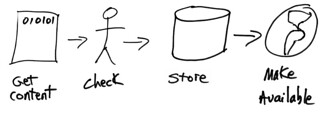
Speakers: Krystie (Klahn) Wilfon, Columbia University; Laura Schimming and Elsa Anderson, Icahn School of Medicine at Mount Sinai
Columbia has reduced their print collection in part due to size, but more because their users prefer electronic collections. Wilfon has employed a systematic collection of cost and data over time, a series of analysis templates based on item type and data source, and an organized system of distributing the end product. [She uses similar kinds of metrics I use in my reports, but far more data-driven and detailed. She’s only done this for two years, so I’m not sure how sustainable this is. I know how much time my own reports take each month, and I don’t think I would have the capacity to add more data to them.]
Mount Sinai had a lot of changes in 2013 that changed their collection development practices. They wanted to assess the resources they have, but found that traditional metrics were problematic. Citation counts don’t factor in the resources used but not cited; journal impact factors have their own issues; etc. They wanted to include altmetrics in the assessment, as well. They ended up using Altmetrics Explorer.
Rather than looking at CPU for the journal package as a whole, she broke it up by journal title and also looked at the number of articles published per title as a percentage of the whole. This is only one picture, though. Using Altmetric Explorer, they found that the newsletter in the package, while expensive in the cost per use, had a much higher median Altmetric score than the main peer reviewed journal in the package (score divided by the number of articles published in that year). So, for a traditional journal, citations and impact factor and COUNTER usage are important, but maybe for a newsletter type publication, altmetrics are more important. Also, within a single package of journal titles, there are going to be different types of journals. You need to figure out how to evaluate them without using the same stick.


